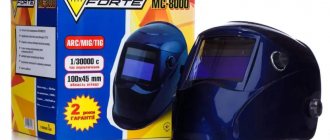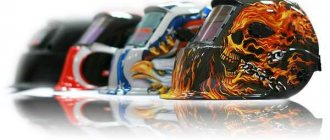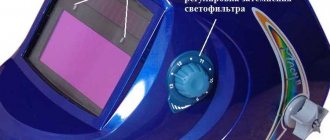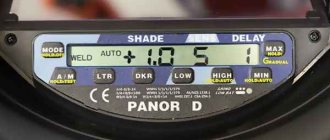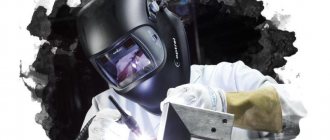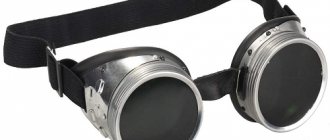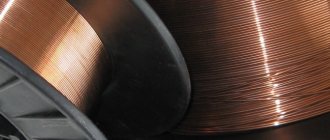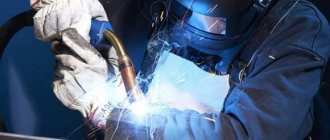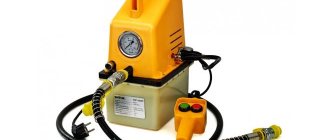The work of a welder involves health risks. When a welding arc occurs, the worker’s skin and eyes are exposed to infrared and ultraviolet radiation, heat, and may also be damaged by specks of molten metal. A protective helmet protects the worker’s face from mechanical impact, and light filters on the welding mask reduce the effect of radiation on the eyes to zero.
Manufacturers produce different welding glasses, whose classification is determined by many factors, for example, the equipment used for work. One thing is certain: the choice of a light filter for a welding helmet directly depends on the degree of darkness of the glass.
Types of glass
There are three main types of glasses for welding helmets on the welding equipment market:
- With constant or constant darkness.
- With variable dimming (they are called chameleons).
- Magnifying glasses with diopters.
Glass with constant darkness
The darkening of permanent filters is created by adding copper and nickel metals to the product. Most often they are used in gas and electric arc welding machines. If the current changes frequently during work, the welder needs to quickly select the right filter. This is inconvenient because it takes time and wastes the master’s energy. In addition, nothing is visible through such a filter until welding begins. These are the disadvantages of such glass. But they are distinguished by their durability and affordable price.
Constant dimming filter
Variable dimming filters
Chameleon light filters for welding helmets are much more convenient and functional. Representing a liquid crystal screen, they are able to reduce the transmission of light due to the fact that the particles alternate the sequence of their arrangement. In addition to several LCD screens, the glass kit includes an infrared and ultraviolet protection screen and a polymer designed to protect against metal drops.
Automatic chameleon filter
During welding, the chameleon mask allows you to see the surrounding space, which greatly simplifies the work process. Unlike permanently darkened glass, chameleons are more expensive because they are a complex device.
Magnifying glasses
In fact, diopter lenses are additional equipment. They serve to enlarge the image and are installed between darkening filters. Convenient for craftsmen with low vision or when working with sheets of thin metal.
Glass sizes and material of manufacture
Most masks have a standard glass size - 110x90 mm, but sometimes there are non-standard sizes. Make sure that such masks come with spare glasses, then you won’t have to look for a non-standard element, which can be very problematic.
Welding helmets use polycarbonate glass. They have increased strength and can withstand high temperatures. Polycarbonate differs from ordinary glass in that it is less fragile and more resistant to various influences, including mechanical ones.
Marking of filters
The filter markings indicate the following characteristics:
- Degree of darkness.
- Optical glass type.
- Light scattering indicator.
- Uniformity of shading.
- Angular dependence.
Darkness level
The main parameter by which glass is selected for certain jobs. Modern filters may use Russian or foreign markings, depending on the manufacturer. Domestic designations range from C1 to C13, but most often glasses with markers from C4 to C8 are used for welding masks.
| Glass class | Error indicator |
| 1 | 0.1 DIN |
| 2 | 0.2 DIN |
| 3 | 0.3 DIN |
European samples are marked from 7 to 16 DIN, although it is more likely to use filters with a rating from 8 to 14 DIN. The degree of shading is better for glasses with a larger number in the marking.
Conformity table between Russian and foreign markings of light filters
| Russian classification | Foreign classification |
| C4 | 9 DIN |
| C4 - C5 | 10 DIN |
| C5 | 11 DIN |
| C6 - C7 | 12 DIN |
| C8 | 13 DIN |
Optical glass type
After the darkness marker on the glass, 4 numbers are indicated separated by a slash. The first number refers to the classification of the filter according to its optical characteristics. It indicates how clearly objects are visible: 1 – no distortion, 2 – average distortion, 3 – periodic distortion of visibility.
The degree of curvature depends on the materials used to make the product.
Light scattering index
Depends on the quality of the liquid crystals that are used for automatic dimming. The faster they react to changes in current during welding and change their position, the clearer the image will be. Just like with an optical characteristic, clarity has 3 degrees, the first of which indicates the clearest image possible, the second - a slight blur, and the third - the periodic occurrence of blurred areas.
Shading Uniformity
Because classic filters contain mixtures of metals, the bonding may be uneven during their manufacture. This will result in less darkness in some areas and more in others. The numerical designation of this classification indicates the maximum error rate.
Angular dependence
The welding flash hits the filter at a certain angle. This parameter specifies the degree of darkness depending on the reflection angle. The higher the number, the weaker the protection is. This parameter has three designations from 1 to 3.
An example of marking a welding filter
Additional markings
You should be aware that some manufacturers indicate additional parameters in the labeling of light filters.
Chameleon mask how to choose
In addition to the filter parameters, there are many other settings and features that can affect the choice.
- Number of arc detection sensors. There can be 2, 3 or 4 of them. They react to the appearance of an arc. Visually they can be seen on the front panel of the mask. These are small round or square “windows” on the surface of the filter. For amateur use, 2 pieces are enough, for professionals - the more, the better: if some are blocked (blocked by some object when welding in a difficult position), then the rest will react.
Electric arc sensors are visible to the naked eye - Filter response speed. The spread of parameters here is large - from tens to hundreds of microseconds. When choosing a mask for home welding, drill one whose chameleon will darken no later than 100 microseconds. For professionals, the time is less: 50 microseconds. We sometimes don’t notice light impacts, but their result is tired eyes, and professionals need them all day long. So the requirements are stricter.
- Filter sizes. The larger the glass, the more visibility you get. But the size of the light filter greatly affects the cost of the mask.
- Smooth or stepwise adjustment of the degree of darkness. Better - smooth. If the filter darkens/brightens intermittently, you will quickly get tired. In addition, it may start to “blink” due to glare, which will not please you.
- Initial shade level and adjustment range. The lighter the filter in its original state, the better you will be able to see before welding begins. It is also desirable to have two dimming ranges: to small degrees up to 8DIN when working with argon or when manual arc welding in poor lighting. Also, an older person may need less darkening. To work with inverters at high currents and in good lighting, a shading of up to 13 DIN is required. So it's better if there are two modes: 5-8DIN/8-13DIN.
- Power supply. Most auto-darkening welding helmets have two types of power supply: solar and lithium batteries. This combined power source is the most reliable. But at the same time, the lithium battery compartment must be opened to make it possible to replace failed batteries. Some cheap masks have integrated batteries: you can remove them only by cutting the plastic (which our craftsmen sometimes do).
One of the models of the chameleon mask. Here you can also see the mask position regulator on the head and the neck protection shield - Weight. Masks can weigh from 0.8 kg to 3 kg. If you have to carry a three-kilogram weight on your head for seven or eight hours, by the end of the shift your neck and head will feel like wood. For amateur welding, this parameter is not very critical, although it is also not at all comfortable to work in a heavy mask.
- Easy to attach to the head. There are two systems for attaching the headband and the shield itself, but for these masks they are almost unimportant: you don’t need to raise/lower the mask every time. It can be omitted throughout the entire work. What matters is how many adjustments there are and how tightly they allow you to fit the headband. It is also important that all these straps do not press or rub, so that the welder is comfortable.
- There is an adjustment that allows you to move the shield away from your face. This is important if you need glasses for normal vision. Then the shield needs to be moved away from your face to accommodate your lenses.
Among the useful, but optional modes, there is also the ability to switch maki from welding mode to grinding mode. With this switch you actually turn off the power to the light filter, your mask becomes a regular shield.
Read about choosing a welding machine for your home or cottage here. You can try the purchased mask when making a metal barbecue.
Selecting a filter
Before purchasing protective equipment for welding, you need to determine exactly what the choice of a light filter depends on. The characteristics listed above can help you purchase a good, high-quality product that will protect the technician’s eyesight and face, as well as make his work easier.
When choosing welding glass, you need to pay attention to the following issues:
- Filter sizes. It is important to select a product that fits the size of the welder’s shield or mask, otherwise there is a risk of encountering problems before work begins.
- Filter type: permanent or automatic dimming. It may depend on the goals pursued by the master, for example, to use equipment for the same work. In this case, it is enough to purchase glass with a permanent darkening of one reading. If frequent welding and changes in current strength are expected, it is better to opt for automatic chameleon masks. They allow you to adjust the degree and speed of darkness, and through them you can clearly see the surrounding space.
- Dimming response speed. An important parameter that allows you to maintain eye health. If the speed is not satisfactory for some reason, it is most likely due to a malfunction of the mask or its improper use. You should read the instructions or replace the filter with a working one.
- The presence or absence of additional protection. Additional protection on the filters is provided by a polymer film that improves visual characteristics and protects the mask from impacts of small solid particles.
Operating the Welding Chameleon
The main requirement for caring for the mask: the light filter must be taken care of: it is easily scratched. Therefore, you cannot put the mask face down. It should only be wiped with a completely clean and soft cloth. If necessary, you can moisten the cloth with clean water. DO NOT wipe with alcohol or any solvents: the filter is covered with a protective film that dissolves in these liquids.
There is one more feature of any welding chameleons: they begin to “slow down” at low temperatures. That is, they operate with a delay, and in both directions - both for darkening and for brightening. This feature is very unpleasant, so you won’t be able to work normally in them in winter, even if the operating temperature is specified as -10°C, as on the TECMEN DF-715S 9-13 TM8. Already at -5° everything cannot darken in time. So in this regard, OTOS turned out to be more honest, indicating the starting operating temperature from -5°C.
Finally, watch the video on how to choose a chameleon mask for welding.
Possible malfunctions and ways to eliminate them
An automatic light filter for a welding helmet is a complex invention, and sometimes malfunctions may occur in its operation. Some can be fixed with professional repairs, while others can be fixed on your own.
| Malfunction | How to fix |
| Dimming occurs unevenly | Correct the distance between the glass and the eyes |
| Flickering, poor dimming | Clean the filter or replace it with a new one |
| Response is delayed | Move work to a room where the temperature is above -5 ° |
| Blur | Clean the filter, adjust the lighting, adjust the settings correctly |
Having knowledge about choosing a good and high-quality light filter, you can safely go to the store and buy a product that meets your needs.
